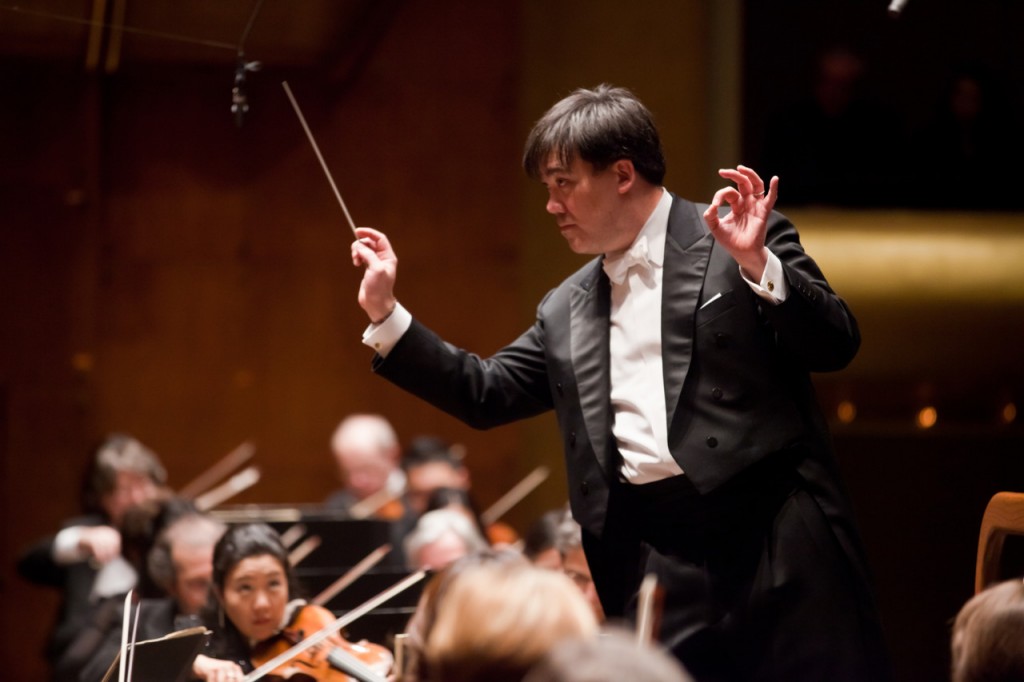Gilbert, Philharmonic soar in magnificent night of Nielsen

Alan Gilbert conducted the New York Philharmonic in a Nielsen program Wednesday night at Avery Fisher Hall. File photo: Chris Lee
Despite the skill and flair the New York Philharmonic has played with under Alan Gilbert, they’ve not put their stamp on any particular part of the repertoire, the way the Boston Symphony is renown for Debussy and Ravel, or Chicago is for Mahler and Bartók. To be fair to Gilbert, the Philharmonic has not put their stamp on much of anything since the days of Leonard Bernstein.
That has now changed with the Philharmonic’s “Nielsen Project.” This series of four concert recordings of Carl Nielsen’s symphonies (and the flute and violin concertos) began in 2012, and produced an excellent CD of Symphonies No. 2, “The Four Temperaments,” and No. 3, “Sinfonia Espansiva.” The hint was there, and was confirmed by Wednesday night’s magnificent concert of Symphonies No. 1 and No. 4, “The Inextinguishable,” and the Helios Overture, at Avery Fisher Hall.
The number of empty seats in the hall seemed to indicate that the project is either a hard-sell in New York or not viewed as “ambitious” enough. The first proposition is unfortunate, the second is preposterous. Nielsen, like Bruckner, has been slow to catch on with classical audiences in America (this was, surprisingly, the first performance of Symphony No. 1 by this orchestra), who tend to see him as a decent enough composer but provincial and second rate.
Nielsen was a great symphonic composer (and no slouch for chamber and vocal music), the equal of Shostakovich and Sibelius, with a sound and style that, despite hailing from the backwaters of turn-of-the-century Denmark, has fewer regional and national qualities than his more famous peers. He is similar to Sibelius in that each of his six symphonies is very different than the other, while all are built around a consistent set of virtues.
Gilbert has shown an avid curiosity in modernism, but is clearly most enthused by the Romantic era composers, and these symphonies suit him and the musicians perfectly. Nielsen was an avowed believer in the basic building blocks of structure and form: intervals, harmonies, counterpoint, canon, solid rhythms. Ordinary stuff, but arrayed in idiosyncratic ways. Nielsen is often connected to Brahms, and equals that emotional intensity, but his closest musical match is Schumann: he’s full of surprises.
Take the seductively long string melody that opens the Andante of Symphony No. 1: it glides through a distant modulation, then off-handedly slides into a cadence before eliding into a secondary theme. Gilbert understands the shape of the music and allowed it to flow—the emphasis was on where it was going, not what it was doing. He brought out unusual fullness in the string section, here and throughout the concert. The polyphonic opening movement of this symphony seems modeled after Schumann’s Symphony No. 2.
Counterpoint in these pieces often sets lines in opposition, forcing them through to dramatic conflict and resolution: development that works both structurally and emotionally. This is red meat for Gilbert. His tempos are passionate—they pick up on the music’s constant, inexorable forward drive and add a sense of quickness and purpose without haste. Gilbert and musicians conveyed a joyous sense of striding towards the grand reward of the music’s ravishing, unsentimental climaxes.
The string playing was beautiful throughout—the musicians did the seemingly impossible in Avery Fisher Hall of projecting a true triple-piano to open and close the gorgeous Helios Overture. Yet it was the horn section that gave a stunningly beautiful weight and richness to everything. The overture describes, with radical clarity, the rise and set of the sun, and Nielsen has the horns play a tremendously difficult series of cascading, wide, upward intervals. The section did struggle with these, but gained cohesion with their choir that marks full daybreak, playing with a fullness and presence that were spine-tingling. The Nielsen sound brings out the best in the Philharmonic: muscular, warm, open-throated, even slightly rough playing that seems ideal. Everyone has a chance to play not just loud but with gusto. Every bar was gripping.
If the playing of Symphony No. 1 was exciting, Symphony No. 4, after intermission, was blazing. The piece doesn’t begin so much as it erupts, quickly followed by gentle, lyrical music in the strings and winds. The orchestra’s intensity and expression was just as compelling when quiet. Every phrase was played with the sense that a powerful meaning lay just under the surface, and that there was an emotional and intellectual purpose behind all the notes.
The “Inextinguishable” seems the platonic ideal of Nielsen symphonies: quirky phrases within straightforward forms, an unerring horizontal line, exquisite pace, and the eccentricities: not just a timpani solo but dueling timpanists. The individual moments were thrilling but the details were nothing compared to the whole. No one plays Nielsen better than Gilbert and the New York Philharmonic, and the orchestra is at its finest when playing the Danish composer’s still-underrated music.
This program will be repeated 7:30 p.m. Thursday, 2 p.m.Friday, and 8 p.m. Saturday. nyphil.org
Posted Mar 17, 2014 at 9:37 pm by Richard Atkinson
I was similarly stunned that this was the Philharmonic’s premier of Symphony #1, a work that I have always ranked higher than anything by Tchaikovsky, Dvorak, or Sibelius (much closer in stature to the Brahms symphonies). At the end of Symphony #4 came the longest standing ovation I’ve ever heard at Lincoln Center – I think many audience members had never heard it before and were completely awestruck (as I was when I first heard it). I can’t agree with your assessment that “no one plays Nielsen better,” since many Scandinavian orchestras play his music much better. His symphonies are part of their regular repertoire, so all the musicians know the music well, and it shows. As good as the NY Phil’s performance was, it did seem like they were quasi-sight-reading some portions.